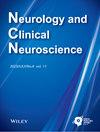Neurophysiological mechanisms of gait disturbance in advanced Parkinson's disease patients
IF 0.4
Q4 CLINICAL NEUROLOGY
引用次数: 2
Abstract
This review considers pathophysiological mechanisms of posture‐gait disturbances in Parkinson's disease (PD). Clinical studies have shown that posture‐gait disturbance attributes to the dysfunction of the whole neuraxis in addition to the musculoskeletal system. The cerebral cortex, basal ganglia (BG), cerebellum, brainstem, and spinal cord temporally and spatially integrate and coordinate multisensory feedback and efferent copies of the motor command. Therefore, the extensive repertoire of voluntary movements can be coupled with anticipatory and reactive postural adjustments to provide the framework for supporting and stabilizing the goal‐directed gait activity. Redundancies in the system allow adaptation and compensation through reward‐oriented and error‐based learning processes implemented through the BG and cerebellar pathways, respectively. However, the impairment of these systems in PD may considerably compromise the capacity to adapt and lead to maladaptive changes impairing posture‐gait control. When these impairments occur, the risk of falls can significantly increase, and interventions are required to reduce morbidity. The damage in dopamine (DA) neurons is the primary cause of PD. Insufficient DA supply in the striatum disturbs the operation of intrinsic networks in the BG. This also pathologically increases GABAergic BG output to the cerebral cortex and brainstem, resulting in functional disconnection of other structures from the BG. The disconnection makes PD patients disable to achieve habitually acquired automatized gait control. Moreover, Lewy body degeneration in most brain areas, particularly in cholinergic and other monoaminergic systems vulnerable to neurodegeneration, further disturbs posture‐gait control and alters non‐motor symptoms of PD.晚期帕金森病患者步态障碍的神经生理机制
这篇综述考虑了帕金森病(PD)中姿势步态障碍的病理生理机制。临床研究表明,除了肌肉骨骼系统外,姿势步态障碍还归因于整个神经轴的功能障碍。大脑皮层、基底神经节(BG)、小脑、脑干和脊髓在时间和空间上整合和协调运动命令的多感官反馈和传出副本。因此,广泛的自主运动可以与预期和反应性姿势调整相结合,为支持和稳定目标导向的步态活动提供框架。系统中的冗余允许通过分别通过BG和小脑通路实现的以奖励为导向和基于错误的学习过程进行适应和补偿。然而,PD中这些系统的损伤可能会大大损害适应能力,并导致不适应的变化,损害姿势步态控制。当这些损伤发生时,跌倒的风险会显著增加,需要采取干预措施来降低发病率。多巴胺(DA)神经元的损伤是PD的主要原因。纹状体中DA供应不足会干扰BG中固有网络的运作。这也会在病理上增加大脑皮层和脑干的GABA能BG输出,导致其他结构与BG的功能断开。断开连接使PD患者无法实现习惯性获得的自动化步态控制。此外,大多数大脑区域的路易体变性,特别是易受神经退行性变影响的胆碱能和其他单胺类系统,进一步干扰姿势步态控制,并改变帕金森病的非运动症状。
本文章由计算机程序翻译,如有差异,请以英文原文为准。
求助全文
约1分钟内获得全文
求助全文

 求助内容:
求助内容: 应助结果提醒方式:
应助结果提醒方式:


